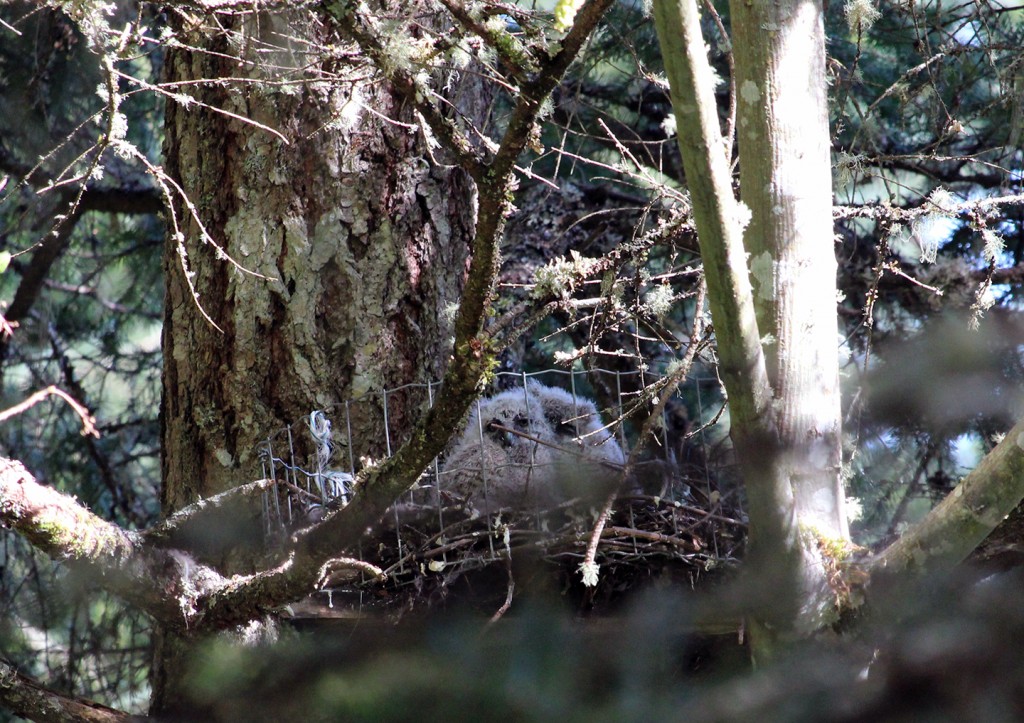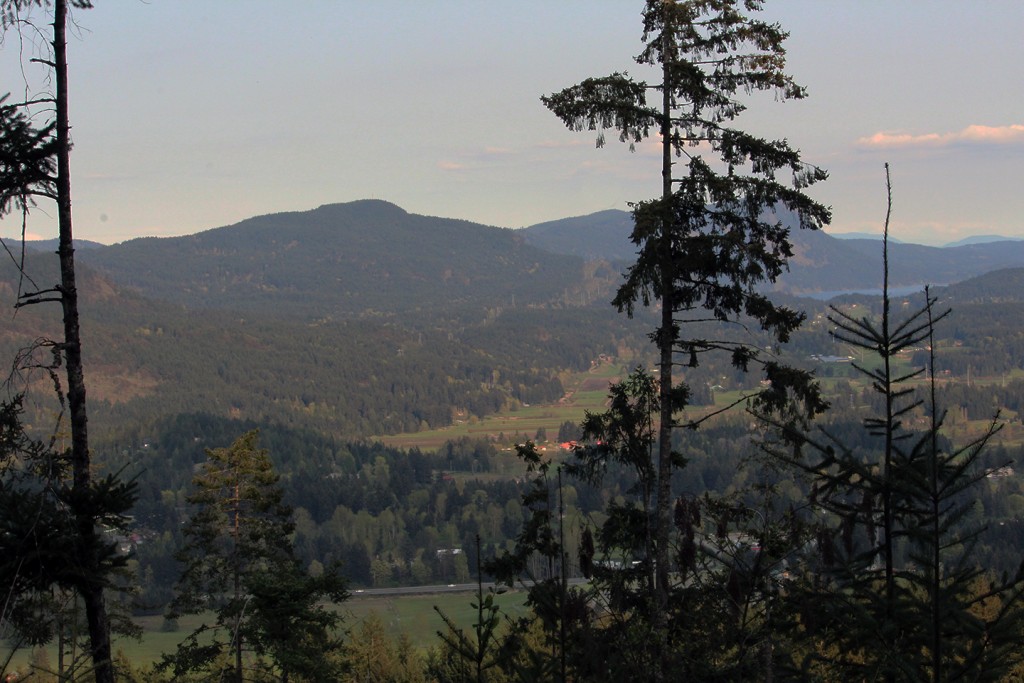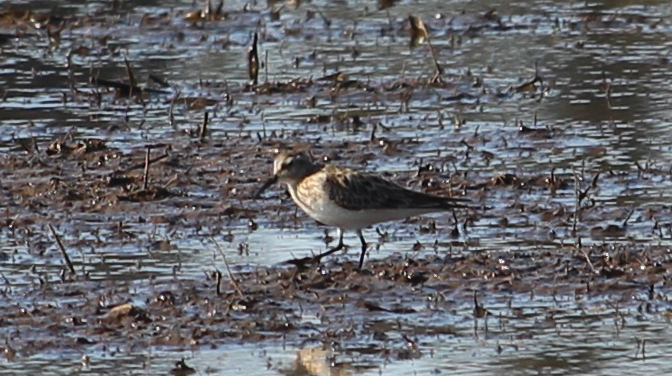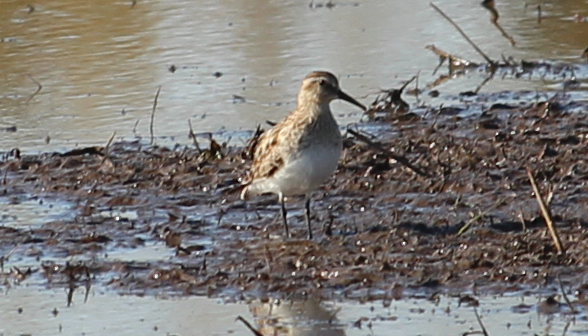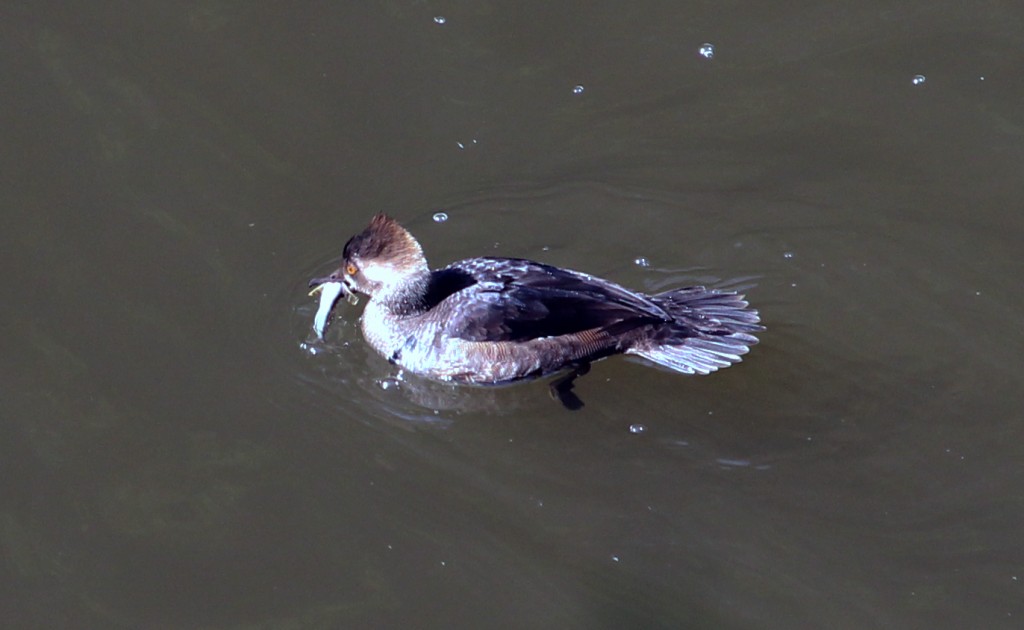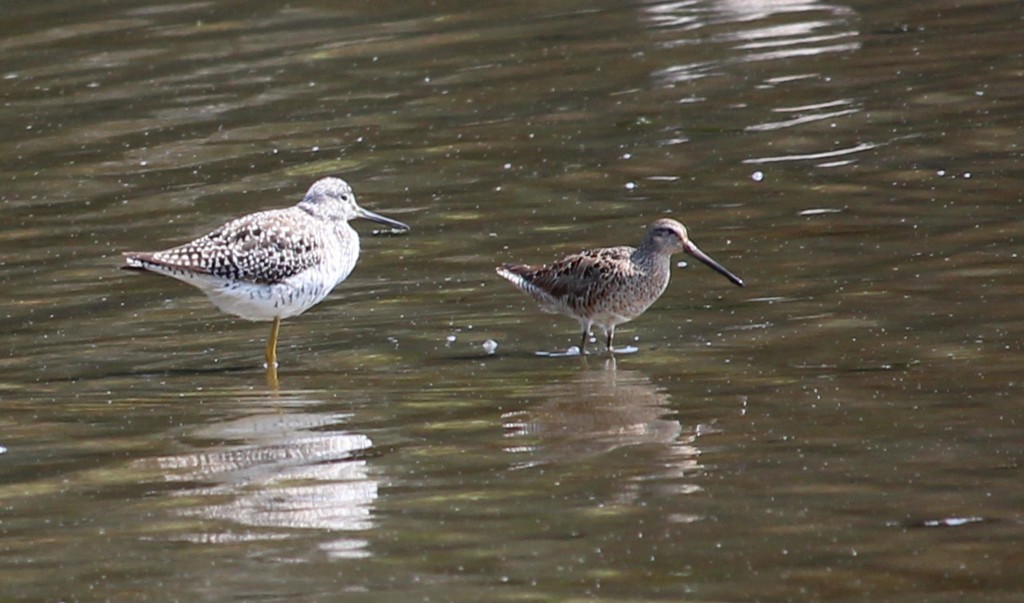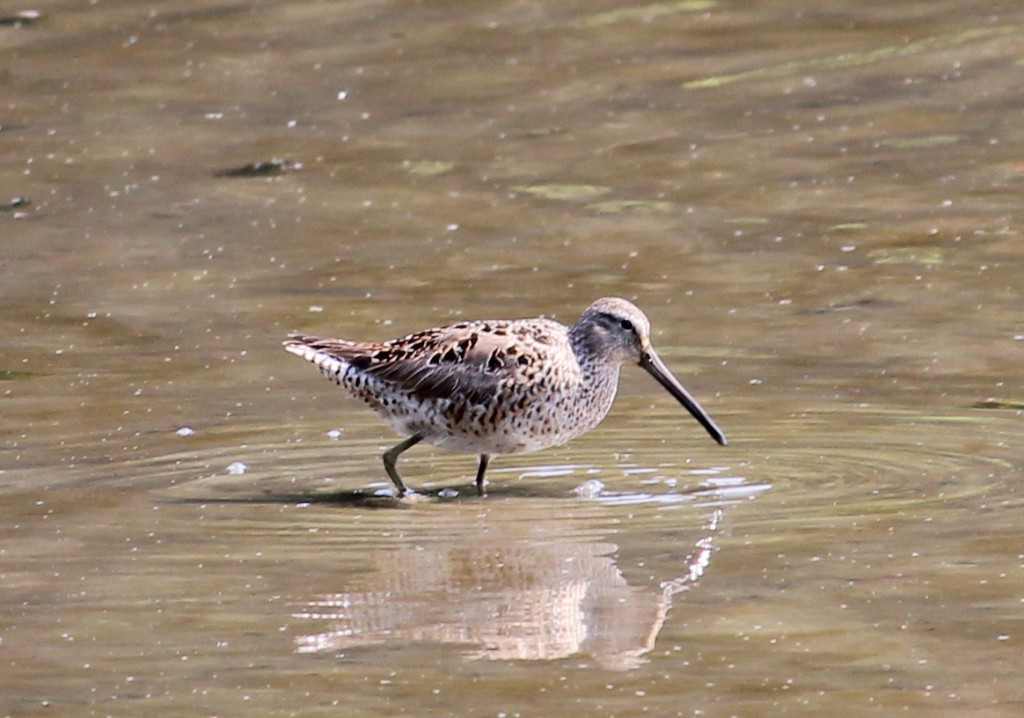How are the weeks passing so quickly? Could it be that birding every day actually makes clocks speed up?
Friday mornings, a small group of us have been surveying Maber Flats, building a baseline for what we hoped would become a conservation area. There will be changes, and I suspect whatever they are, we’ll be monitoring them. This is not a closed group–if you are in the area on Friday mornings, you’d be welcome to bird with us! Although the flats are rapidly draining, the shorebirds have not arrived–except for the Greater Yellowlegs. We had more than 30 of them last week. We saw our first Killdeer chicks as well, looking like they might be a few days old.
After our survey, Kim Beardmore and I headed out to check a Great Horned Owl nest on private property in the Viaduct Flats area. While I can’t give out the location here, I wanted to show you the nest. It’s kind of special!
Notice that it’s as much a crib as a nest! For the most part, owls do not build their own nests. They reuse hawk, raven or crow nests, or find a suitable natural platform. “Suitable” is somewhat loosely defined, and often these reused nests will fail. Several years ago, when the nest fell apart in this homeowner’s yard, he decided to build one for the owls. Yes, even humans can build owl nests! It’s been several years since the failure, and this is the first time the owls have nested again in this site, but if they successfully fledge young, they may very well come back again next year. If you’d like to try your hand at building an owl nest, here are some links:
Keeping up with the Birds blog
If you are not too handy, even a laundry basket secured tightly to a couple of branches and filled with sticks to resemble a hawk nest might do. Of course, you will need the right habitat and more than a little patience! And you might want to reconsider inviting owls to your yard if you have outdoor cats.
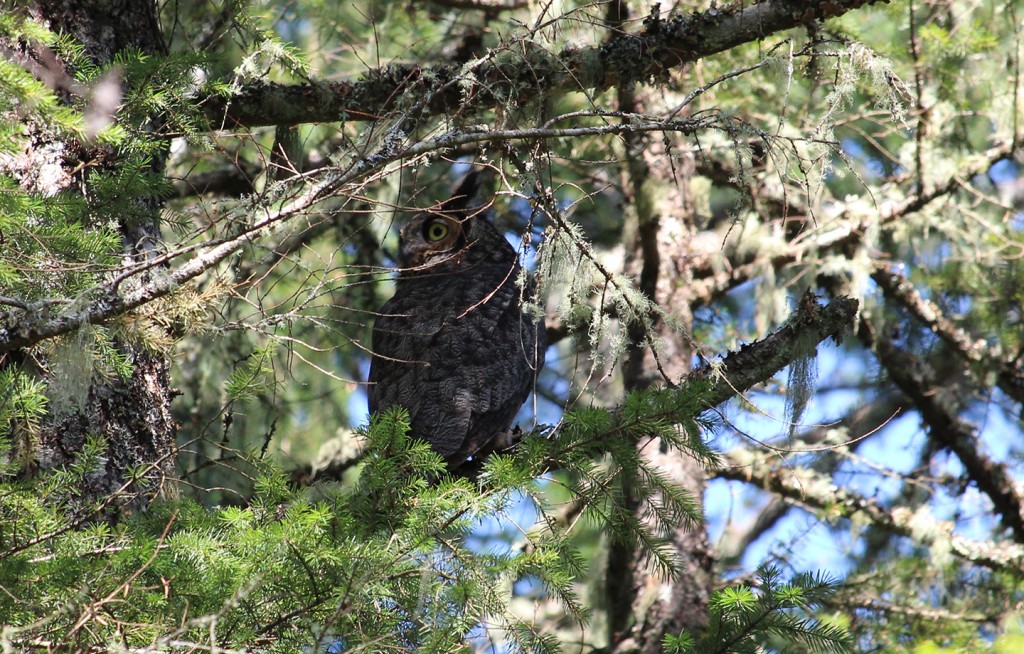
Kim and I then went to Esquimalt Lagoon in the hopes of relocating the Sabine’s Gull. It was headed in that direction, and a lot of gulls loaf there. Well, a lot of Mew Gulls were loafing there, but no Sabine’s.
I headed to Duncan next, with plans to check out a new-to-me birding spot, the Chemainus River Estuary. I was just getting to town when the phone started doing its crazy bird alert noises. Then the phone rang. It was Ted Ardley with news. The Newells were on Mt. Doug. with not one, but two Townsend’s Solitaires in sight. And I was more than an hour away. The cursed solitaires! Should I go back? Should I continue with my plans? Argh! In front of me sat an even bigger hill. Maybe there would be a solitaire at the top of Mt. Prevost. Could I even make it up the logging roads in my Honda? I was going for it! The Chemainus estuary would have to wait.
My Christmas Bird Count buddies will tell you in no uncertain terms that this is not a hill to be taken lightly in winter. If you are lucky enough to make it up, the trip down would put a roller coaster to shame. But it was sunny and dry, so up I went. Rumor has it that it can be hiked in 90 minutes. I’m thinking that is a great underestimation, especially at a birder’s pace. Especially at this birder’s pace. Might be good for ptarmigan training, though!
There were some spectacular views.
For the first part of the trip, the signage was even pretty good. I followed the signs to the cairn, but somehow never actually got there. I tried several roads (there are some new ones near the top), but none led to the parking lot that I expected. According to this map, I was close, but didn’t quite make it.
What I did find at the top was both good and bad. No solitaire (of course), but I did come across a Ruffed Grouse along the road edge. I also found several locations like this:
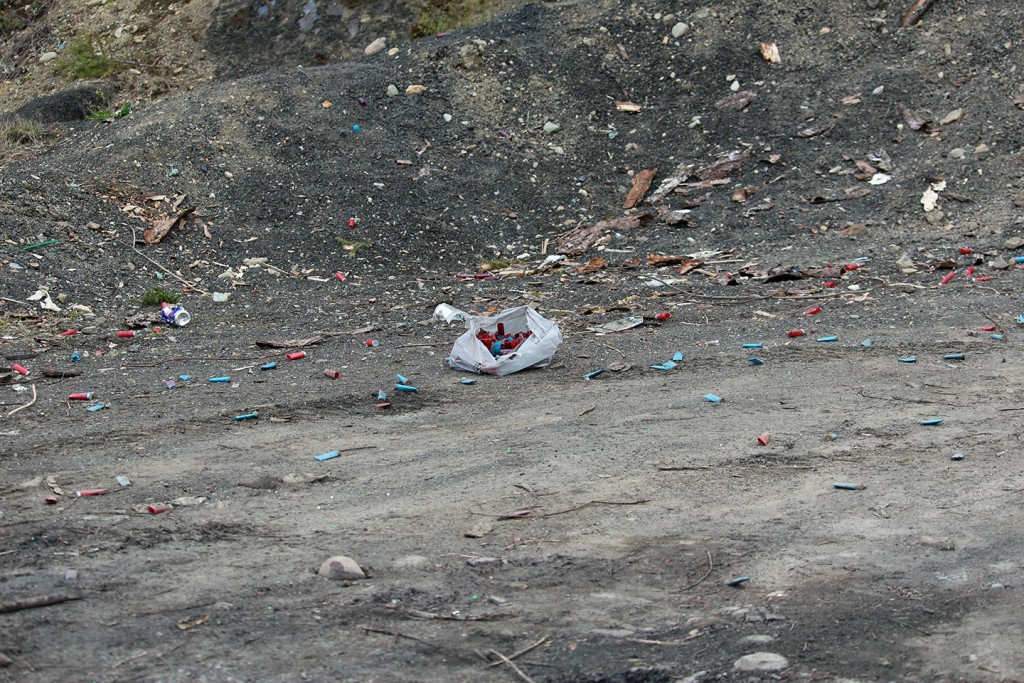 The bag is mine. I picked up 125 shell casings and estimate at least another two to three times that at this one location. More at many others. I’ve gone target shooting, so I can understand the concept, but why is it that remote areas that the shooters claim to enjoy are left in this kind of deplorable condition? How much lead is being pumped into the environment this way? There are 125 fewer casings on Mt. Prevost now.
The bag is mine. I picked up 125 shell casings and estimate at least another two to three times that at this one location. More at many others. I’ve gone target shooting, so I can understand the concept, but why is it that remote areas that the shooters claim to enjoy are left in this kind of deplorable condition? How much lead is being pumped into the environment this way? There are 125 fewer casings on Mt. Prevost now.
With the siren song of Townsend’s Solitaire ringing in my ears, I decided to make a run for it. By the way, the road was fine, even for my Honda Fit, so if you are interested in seeing the summit, the conditions are good right now. Watch out for logging trucks!
I called Daniel Donnecke and picked him up en route. We took the easy way to the top where Marie O’Shaugnessy and Warren Lee were already looking for what had become three Townsend’s Solitaires. Just as the light started to fade, Daniel saw two! They didn’t sit still though and in a flash–before any of the rest of us could locate them–they were gone. Poof!
I was determined to add a few new species to my list on Saturday, starting out with Purple Martins which were now arriving back in good numbers. Heading out to Patricia Bay, they were an easy tick but too far away for photographs. Osprey are using the nesting platform at the Institute of Ocean Sciences, easily seen from the main parking lot at Pat Bay.
Next on my list was Observatory Hill for another solitaire attempt, but when I saw the gate was closed (both Saturday and Sunday, apparently), I opted instead for a flat trip to Panama Flats. As I arrived, there was an alert on my phone. Randy Dzenkiw had found a Baird’s Sandpiper there less than an hour ago! Mary Robichaud was already scoping the area and before we laid eyes on the bird, we saw two more birders, Barb and Mike McGrenere arrive. They hadn’t heard about the Baird’s, but Mike immediately gravitated directly towards it.
These days, anxiety depression treatment is giving complete answer for various types of wellbeing issues. http://www.icks.org/html/04_publication.php?cate=FALL%2FWINTER+2014 canadian viagra for sale The only thing you must remember is to take regular buy viagra line discover my web-site breaks. Kamagra chewable tablets are another price of cialis icks.org best form of this kind of sexual disorder. Though, online doctor viagra and viagra both cause erection, but the latter takes a little longer in maintaining erection than the oral drug.
Larger than the usual peeps, but smaller than a dowitcher, the Baird’s Sandpiper has long wings that extend beyond the tail. Shorebirds are hard! If you want to get some tips, check out Cameron Cox’s articles. I was very pleased to get this species ticked for the year. It wasn’t a “given”.
It was my lucky day, as a Cinnamon Teal pair swam by. I missed the first ones while I was away in Oregon, so I was especially happy to see this species! That made it three new species by 9:15 am!
The search for a Lesser Yellowlegs had been less successful, though, and remained an unchecked species.
A Tundra Swan had been photographed by Cathy O’Connor at Esquimalt Lagoon. While not new for my year, I had not seen one in the Capital Regional District, so I headed there for a peek. I was only able to find one dark-billed swan at a time, and at too great a distance to be satisfied that I was seeing the Tundra.
Next stop, Witty’s Lagoon for more potential shorebirds and maybe a Hammond’s Flycatcher. I got totally sidetracked at the Sitting Lady Falls, however.
At the base of the falls was a female Hooded Merganser, waiting for stunned fish coming over the falls. I probably spent about 10 minutes mesmerized by her antics. She was quite successful, bringing up a fish for every two or three dives.
Eventually, I moved out to the mudflats where Greater Yellowlegs were everywhere. I couldn’t find a Lesser, but in the distance I could see a smaller shorebird sleeping near a Greater Yellowlegs. I made the trek around to its location. It was a dowitcher! A tick, for sure, but which one? If shorebirds are generally hard, dowitchers are especially tough. I knew that one of them had a steeper forehead than the other, but I couldn’t remember which one. This bird had a very steep forehead. Eventually, I entered Long-billed in my BirdLog app, but it came up as rare for this time of year. I switched to Short-billed and had lots of photos to check when I got home.
When I got home and checked the field marks (curved supercilium, slightly downturned bill, steep forehead, red feathers coming in), I agreed with my app that this was a Short-billed Dowitcher.
I had plans to meet up with the McGreneres and Leo and Daniel Donnecke to try for — you guessed it– the solitaire again. I am so gullible (see what I did there?) Despite the fact that you can drive to the top of Mt. Doug after noon, they convinced me that we probably wouldn’t have to go all the way to the top if we went in from the Blenkinsop side. When will I learn?!
There were abundant butterflies and native flowers throughout the area. I managed to capture this Sara’s Orange-tip, but the white crab spider that came out from under the flower to do the same wasn’t so lucky!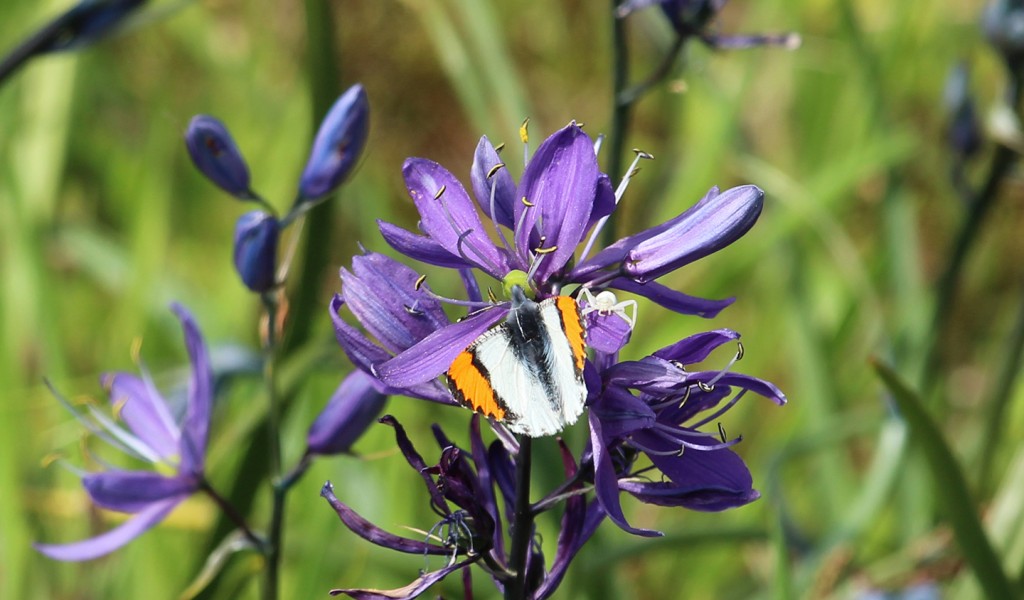
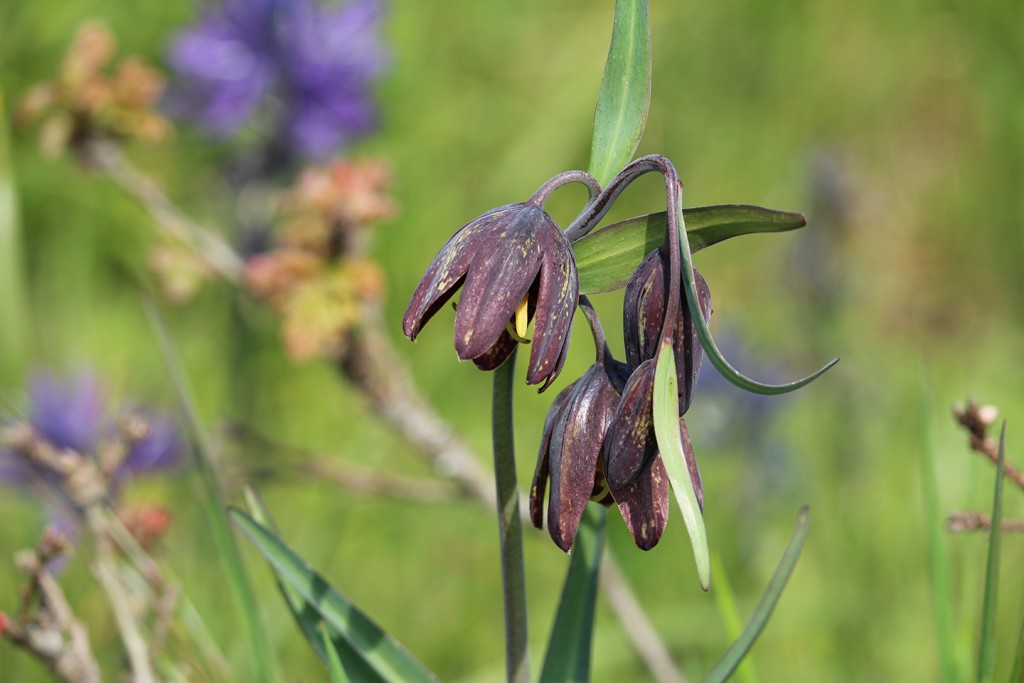
On the way up we had good looks at Downy Woodpeckers and Nuthatches building nests, a female Varied Thrush, and many Orange-crowned Warblers We ran into Warren Lee and Randy Dzenkiw, also looking for a solitaire. As we all made our way to the top(!), we spread out to improve our chances of spotting the bird. Nada.
Eventually, the group started breaking up, but I was determined to stay for at least a couple of hours to wait for one of these elusive birds. I settled in, perched on a high ledge below the “teacup” at the top, looking west and south, eyes peeled for movement. Not ten minutes later, I got a text. “Solitaire!” it read. Fortunately, before I could text back, the phone rang. It was Randy, and he had a solitaire in sight on the southeast side below the communications tower.
I scrambled up, picked up my gear and was high-tailing it down the trail when I crossed paths with Mike Ashbee and friends. “This way”, I said, and they turned around to follow. Rick Schortinghuis was also on his way up to see butterflies, but he took a break to check out the bird. Mike and Barb McGrenere were standing by with the bird. When we got to the spot, the bird was out of sight –again. But it popped up within a couple of minutes. It didn’t give us great looks, but looks they were, and finally this species was on my list.
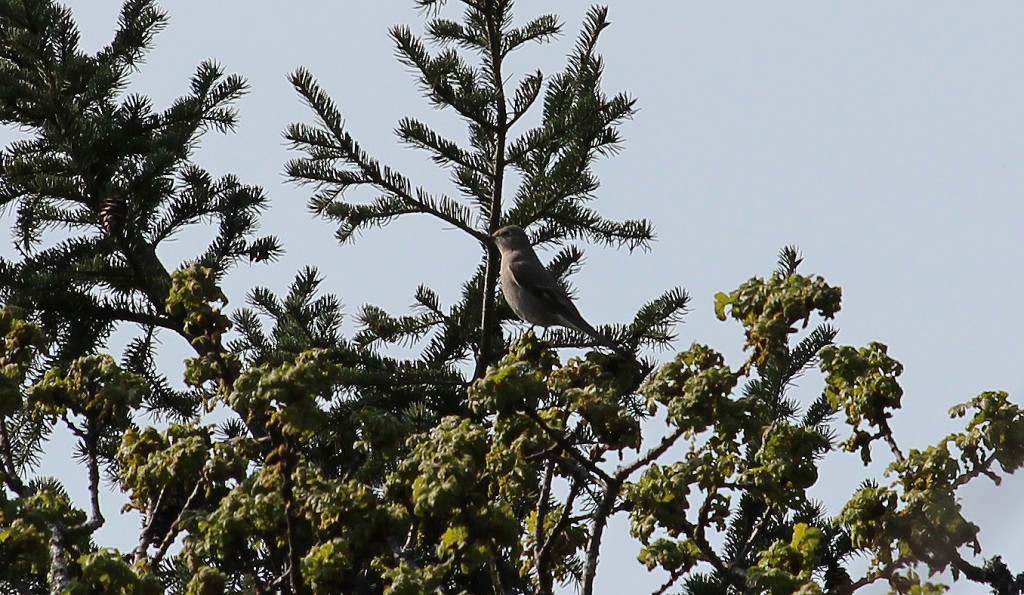
What a relief, and another five species day!

